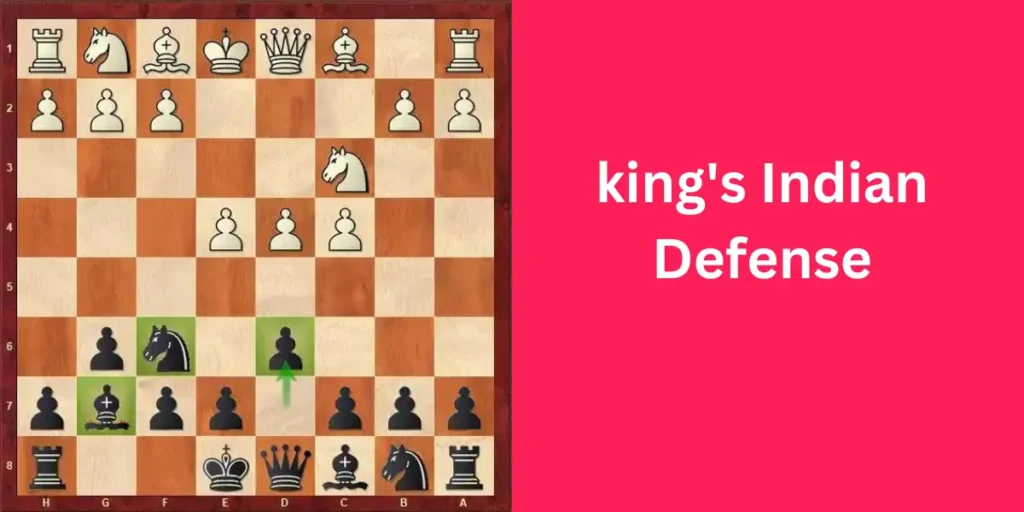This is a step by step guide to King’s Indian Defense.
In this guide, you will learn everything you need to know to start playing King’s Indian Defense confidently.
Mainline theory, middle game ideas and step by step opening moves are covered in this guide.
Let’s start…
What is King's Indian Defense in chess?
This opening is characterized by the initial moves 1…Nf6 2…g6 3…Bg7 and 4…d6.
It is an aggressive way of playing against 1.d4.
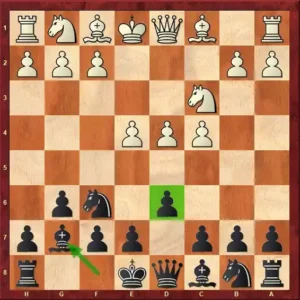
What is Main Idea of King's Indian Defense?
Main idea of King’s Indian Defense is to quickly develop kingside pieces while giving up the control of the center; later in the middle game black will play pawn moves like …e5 or …c5 to attack white’s center.
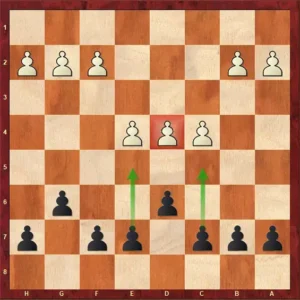
Where do you put your pieces?
In this opening, black first develops his kingside pieces.
g8 knight goes to f6.
f8 bishop goes to g7.
King goes to g8.
b8 knight usually goes to d7 or c6.
Development of light squared bishop is usually delayed until the late middle game.

Is King's Indian Defense good for beginner?
Yes, King’s Indian defense is a good opening not only for beginners but for all levels. It is especially popular among club level players.
If your style is aggressive and attacking then you will definitely like this opening. It is a good antidote to solid opening like London System.
You will get positions that will allow you to launch sacrificial attacks and tactics on your opponent.
This opening has been played by World Champion’s like Bobby ficsher and Garry kasparov with good results.
King's Indian Defense Opening moves step by step
Black plays this opening against white’s first move 1.d4.
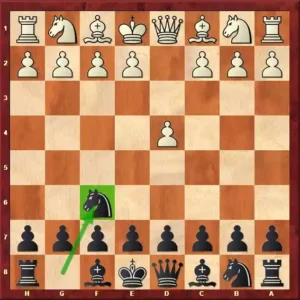
1…Nf6 Black starts by developing his g8 knight to f6 square.
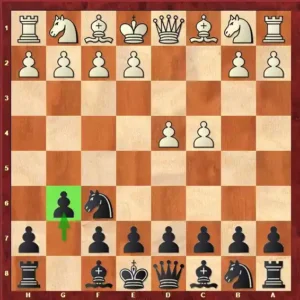
2. c4 g6 Black gets ready to fianchetto his dark squared bishop. Bishop from g7 will attack on the long diagonal.
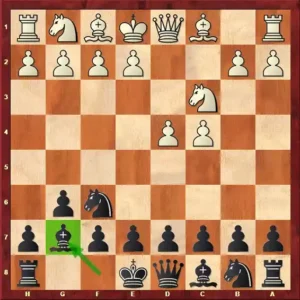
3. Nc3 Bg7 Black develops the dark squared bishop and gets ready to castle short side.
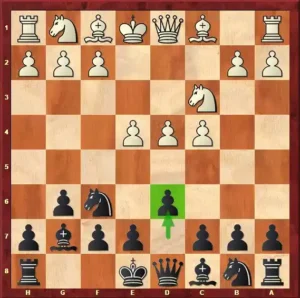
4. e4 d6 It is important to stop white from playing e5.
If white plays 5. e5 now then after 5…dxe5 6.dxe5 Qxd1+ white cannot castle and black is better.

5. Nf3 0-0 Black completes his kingside development and is now ready to attacking white’s center.
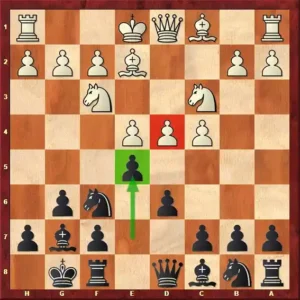
6. Be2 e5 Black immediately strikes in white’s center. If white plays 7.dxe5 dxe5 8.Qxd8 Rxd8 9. Nxe5 then black has a fantastic move 9…Nxe4! with tactics on the e5 knight, thus recovering the pawn.

7. 0-0 Nc6 Black develops his queenside knight and puts more pressure on white’s center.
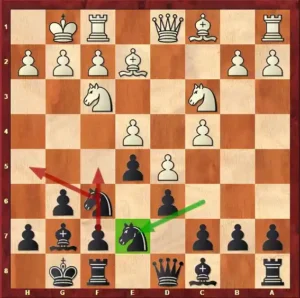
8. d5 Ne7 Black was putting a lot of pressure in the center so white decided to close the center.
Now black’s plan is straightforward.
Black will play …Nh5 or …Ne8 to clear the way for the f7 pawn.
Then push the pawn to f5, later to f4 and start the attack on the kingside.
King's Indian Defense Mainline Theory
White has many different ways to play against King’s Indian defense. Let’s look at the major variations that white can use against you.
Classical variation
This is the most popular variation and it is known as Classical variation. We have already covered it in step by step section.
1. d4 Nf6 2. c4 g6 3. Nc3 Bg7 4. e4 d6 5. Nf3 0-0 6. Be2 e5 7. 0-0 Nc6 8. d5 Ne7
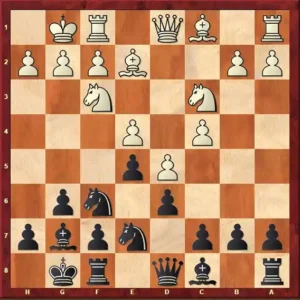
Black plan in this variation is to play …Ne8 or …Nh5 to play f5 and attack on the kingside.
Petrosian Variation
This variation was popularized by the world champion Tigran Petrosian. White plays 7.d5 to stop black’s …Nc6.
1. d4 Nf6 2. c4 g6 3. Nc3 Bg7 4. e4 d6 5. Nf3 0-0 6. Be2 e5 7. d5
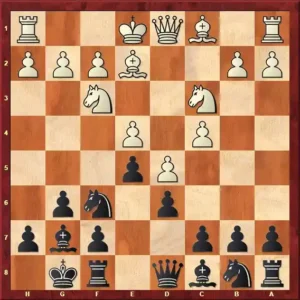
Here black can play 7…a5 with the idea of developing the knight to a6 and then to bring it to c5. Black’s a5 prevents the move b4 by white.
Gligoric Variation
Gligoric Variation arises after the moves
1. d4 Nf6 2. c4 g6 3. Nc3 Bg7 4. e4 d6 5. Nf3 0-0 6. Be2 e5 7. Be3
White’s idea is to support d4 and maintain the tension for few more moves.

In this position, Black can play 7…exd4 8. Nxd4 Re8! with strong pressure on the e-file.
Exchange Variation
After the initial moves
1. d4 Nf6 2. c4 g6 3. Nc3 Bg7 4. e4 d6 5. Nf3 0-0 6. Be2 e5 7.dxe5 dxe5 8.Qxd8 Rxd8
We have reached the exchange variation. Here the central pawns and queens have been exchanged and that’s why it is called exchange variation.

Note that 9. Nxe5 does not work here because of 9…Nxe4! with tactics on the e5 knight.
Black’s main idea is to play …c6 to cover d5 square, develop the b8 knight to c4 via a6 or d7 and develop the light squared bishop to e6.
Samisch Variation
This variation leads to sharp play with players often castled on the opposite sides.
1. d4 Nf6 2. c4 g6 3. Nc3 Bg7 4. e4 d6 5. f3
White’s idea is to play Be3, Qd2, 0-0-0 and attack on black’s kingside by playing g4,h4-h5.

After 5…0-0 6.Be3 Nc6 7. Qd2 e5 8. d5
Black should play 8…Nd4! sacrificing a pawn.
If white played Bxd4 then after exd4 the long dark squared diagonal gets opened and you will have strong attack on the dark squares.
Averbakh Variation
This variation was frequently employed by Yuri Averbakh.
1. d4 Nf6 2. c4 g6 3. Nc3 Bg7 4. e4 d6 5. Be2 0-0 6. Bg5
White’s idea is to prevent immediate 6…e5.
After 6…e5 white can play 7.dxe5 dxe5 8.Qxd8 Rxd8 9.Nd5! and white wins material.
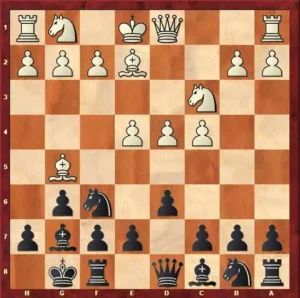
Here black can attack white’s center using the c pawn.
6…c5 7. d5 and now black can play 7…a6 with the idea to play b5 with strong initiative on the queenside.
Four Pawn Attack variation
This is the most aggressive variation for white to use against king’s Indian defense.
1. d4 Nf6 2. c4 g6 3. Nc3 Bg7 4. e4 d6 5. f4
White takes full control over the center but the drawback is that white has not developed the pieces. This approach can quickly backfire if white’s center is overextended.

After 5…0-0 6. Nf3 Black should play 6…c5! immediately attacking white’s center.
7.d5 e6! 8.Be2 exd5 Black can use the open e-file and gets a good game.
Fianchetto Variation
This is the solid way of playing against King’s Indian defense. White does not want to take a lot of risk.
1. d4 Nf6 2. c4 g6 3. Nf3 Bg7 4. g3 0-0 5. Bg2 d6 6.0-0

In this variation, black can play 6…Nc6 7. Nc3 e5! Immediately attacking white’s center.
Conclusion
King’s Indian defense is one of the most aggressive for black to counter d4. It can be played at all levels from beginner to master. Not only you can use this setup against 1. d4 but you can use it against white’s various first moves like 1. c4, 1.Nf3, and 1.f4.
If you consider yourself an attacking player then king’s Indian defense is a good opening for you.

